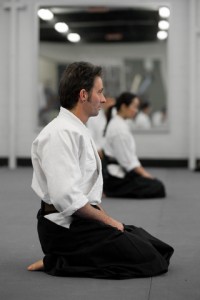Learn Aikido – Why Etiquette is Important
 When you learn Aikido, you realise that like most other traditional martial arts, practice begins and ends with courtesy.
When you learn Aikido, you realise that like most other traditional martial arts, practice begins and ends with courtesy.
Etiquette is a standardised set of behaviours that ensures that everyone acts in a uniform and predictable manner whilst in the dojo. So why is it necessary?
Firstly, it is the way that an otherwise diverse group of active individuals can remain safe during practice. Secondly, it teaches us to pay care, attention and respect to our training partners which, during the course of a class, includes all other students in the dojo.
Aikido is potentially a dangerous activity and requires great concentration. If there is no code of standardised behaviour, how else can 15 -20 people on a mat practice under movement at close quarters without accident or injury?
Bowing a Bokken or Jo onto the mat serves to makes us very aware that we have a dangerous weapon in our hands. Even an accidental bump with a wooden weapon can cause painful injury. A tap on the head can cause damage.
When we bow onto the mat, we are paying respect to Kamiza. This is the place of honour at the front of the mat which symbolises the presence of the founder and the heritage of the art. Bowing on to the mat also serves as an individual reminder to focus on what we are about to do and to do it with a calm, clear mind and no distraction.
When we step onto the mat to practice, we are entering a potentially dangerous place where a high level of concentration and awareness must be maintained. It pays to be respectful when you are about to practice an art that is not a sport; and, in that context, has no rules and no competitions.
We also bow to our training partner not only as a matter of courtesy, but also to signify that we are both ready in mind and body to commence practice. Safe practice and the best opportunity to learn occur when both partners are aware and present in the moment. An attack and response with one partner distracted is an accident waiting to happen.
In terms of respect, bowing means that we are acknowledging our training partner with courtesy, and paying close attention to their needs. It is important to be sensitive to the needs of our training partners because two people are rarely at the same level of ability at the same time, in all aspects of the art.
The need to be sensitive to our training partners is extended further because it has been long established that the most effective way to learn Aikido is through ‘cooperative’ practice. It is an opportunity for two people tuned in to each other (harmonising energy) to learn by applying and receiving techniques in turn. One leads, the other follows; both learn.
It is a waste of that learning opportunity to introduce unwanted resistance. To deliberately impede cooperative practice by repeatedly blocking or offering resistance is nothing more than ego at work, not to mention … very disrespectful to a partner who is kind enough to contribute their mind and body to the other’s learning.
Etiquette is very important when you learn Aikido. Bowing is the outward form of respect; and over time, it is hoped that the inner form follows to the point where genuine care and respect for other people becomes second nature. The more we discover genuine care and respect for others, both in word and deed, the safer we will all be – in or out of the dojo.


